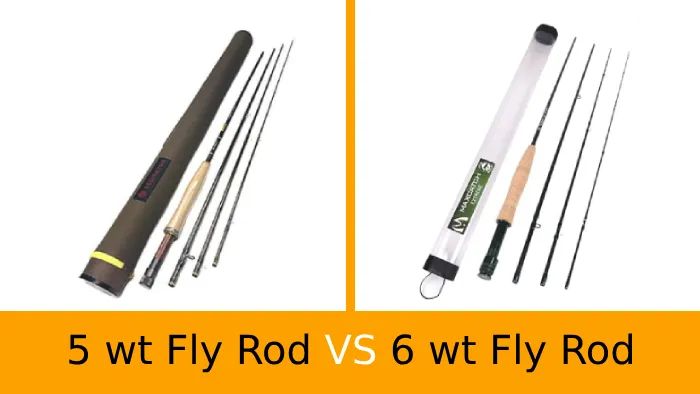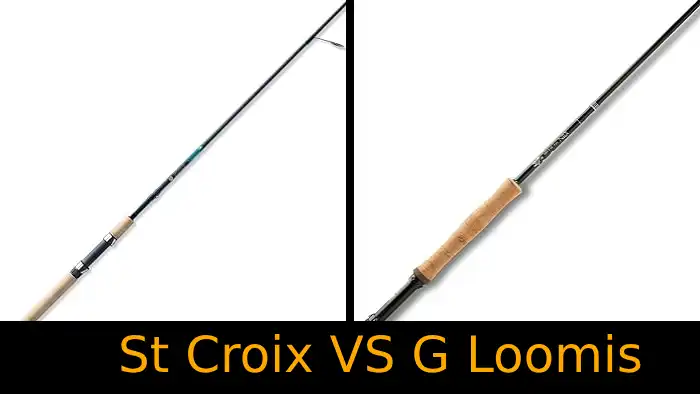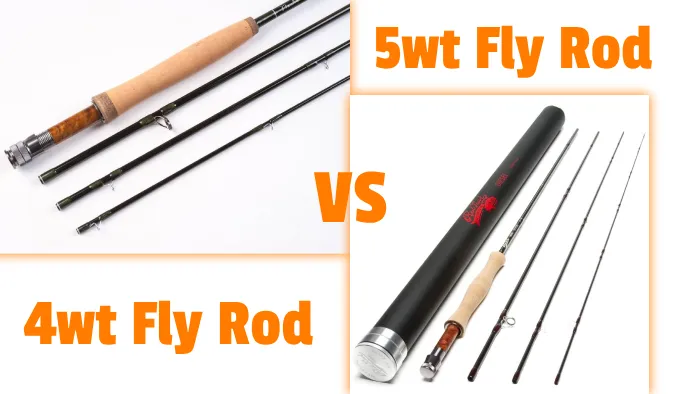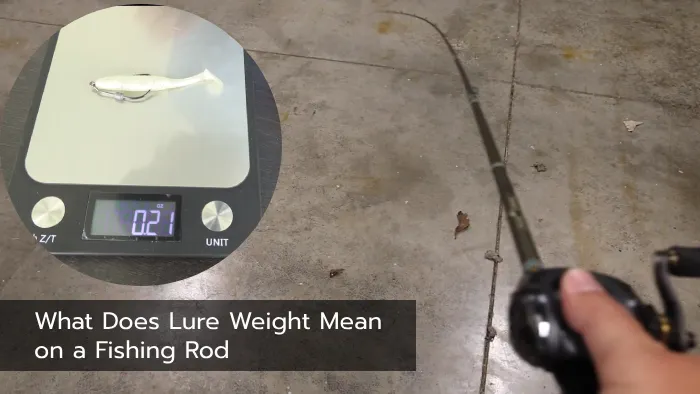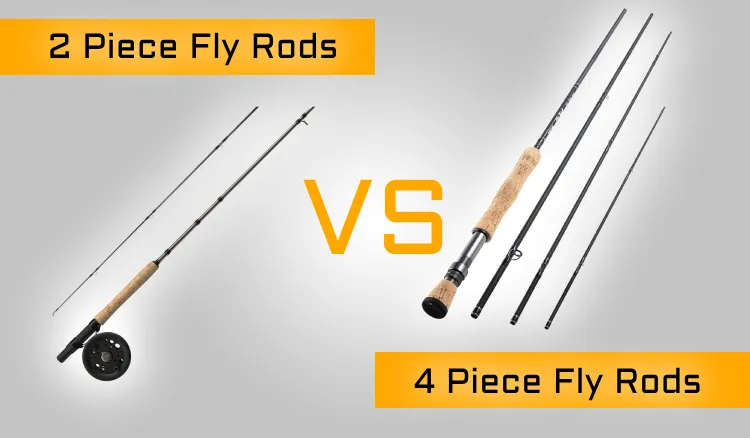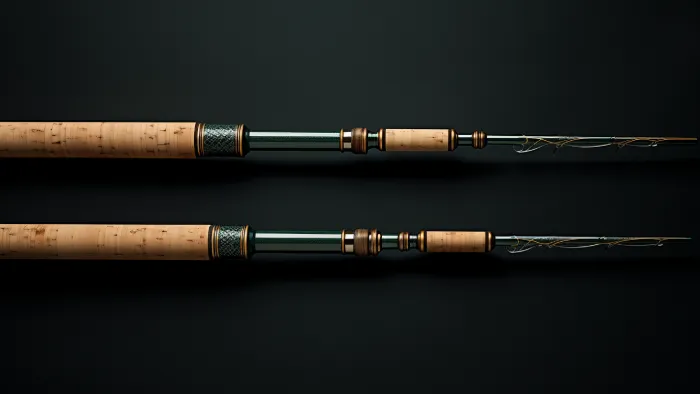5 wt Vs 6 wt Fly Rod: 5 Notable Differences
5 wt and 6 wt fly rods, while both valuable tools in fly fishing, serve distinct purposes that cater to different angling needs.
One key difference lies in the fishing conditions and target species. A 5-wt fly rod is often hailed as the default choice for trout fishing in mountain rivers and small lakes, best suited for smaller trout species.
In contrast, a 6-wt fly rod steps up to the plate, recommended for rivers and lakes, especially for bass, and it proves equally capable with larger trout and other warm-water species.
A 5-wt fly rod is considered versatile, capable of handling everything from delicate dry fly presentations to powerful streamer pulls.
The 6 wt fly rod is more specialized, primarily designed for warm-water fishing, and thus has a narrower application range.
Now, we’ll explore all the differences and uncover which fly rod might be the perfect fit for your angling aspirations.
Differences Between 5 wt Vs 6 wt Fly Rod
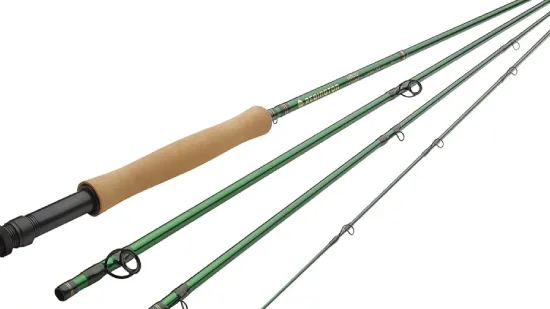
Fly rods of 5 wt and 6 wt differ in some cases and categories. The following are among them:
- Fishing conditions and Target species
- Versatility
- Performance in Windy conditions
- Fish size handling
- Fly types and fishing methods
Check out each difference in detail to determine which rod is right for you.
1. Fishing Conditions and Target Species
When considering the difference between a 5 wt and 6 wt fly rod, you need to consider their ideal fishing conditions and target species.
A 5-wt fly rod is best suited for smaller trout species in mountain rivers and small lakes. This rod is perfect for delicate presentations and light tackle fishing.
However, if you plan on fishing in New York for bass, a 6-wt fly rod is suggested. The 6 wt fly rod is designed for larger trout, bass, and other warm-water species. Choosing the right rod for fishing conditions and target species is important to achieve the best results.
2. Versatility
The versatility of a fly rod is essential in deciding which rod to use for different fishing techniques.
A 5 wt fly rod is considered versatile, and suitable for various trout fishing techniques, including dries, streamers, and dry-droppers on bigger waters.
This rod can handle many different fly types and fishing methods, making it an excellent choice when you need a do-it-all rod.
On the other hand, a 6 wt fly rod is more specialized for warm-water fishing, implying a narrower range of use.
It is best suited for streamers, dry flies, and nymphs in freshwater. Therefore, it is essential to consider the type of fishing you plan to do to make the right choice.
3. Performance in Windy Conditions
Windy conditions can be challenging for any fly fisherman. When it comes to fly rod selection, a 5 wt fly rod may struggle a bit in strong winds, especially when casting large flies. If you plan to fish in windy conditions, it is better to have a 6 wt fly rod.
The extra backbone provided by the 6 wt fly rod offers better performance in windy conditions, providing more control and accuracy, making it easier to cast large flies.
Therefore, for successful fishing trips in windy conditions, consider using a 6 wt fly rod.
4. Fish Size Handling
When it comes to fishing, the size of the fish dictates the type of equipment you should use.
A 5 wt fly rod can handle 2-3 lb bass, but it is more suitable for smaller trout. The smaller rod has less power and may not be suitable for larger warm-water species.
Conversely, a 6 wt fly rod is better suited for catching larger bass and other warm-water species due to its greater power and backbone. Choosing the right fly rod for the fish you plan to catch can make or break your fishing trip.
5. Fly Types and Fishing Methods
A 5 wt fly rod is suitable for various fly types and fishing methods, making it versatile for various trout fishing scenarios.
You can use different types of flies, such as dries, streamers, and nymphs. If you plan to focus on streamers, dry flies, and nymphs in freshwater, a 6 wt fly rod would be the best choice.
The 6 wt fly rod provides better stability and control, making it the ideal choice for these fly types. Therefore, when selecting your fly rod, consider the type of flies and fishing methods you plan to use to make the best choice.
5 wt vs 6 wt Fly Rod Comparison Table
| Aspect | 5 wt Fly Rod | 6 wt Fly Rod |
| Fishing Conditions | Ideal for trout in mountain rivers and small lakes. Suited for smaller trout. | Suggested for Texas rivers and lakes, especially for bass. Suitable for larger trout and bass, as well as other warm-water species. |
| Versatility | Versatile, works with dries, streamers, and dry-droppers on bigger water. | Specialized for warm-water fishing, so fewer uses. |
| Performance in Windy Conditions | May struggle in strong winds, especially with larger flies. | Offers better performance in windy conditions, providing better control and accuracy, so you can cast bigger flies. |
| Fish Size Handling | Capable of handling 2-3 lb bass but more suitable for smaller trout. | With its greater power and backbone, it’s better for catching bigger bass and other warm-water species. |
| Fly Types and Fishing Methods | Suitable for a range of fly types and fishing methods, versatile for various trout fishing scenarios. | Specifically mentioned suitability for streamers, dry flies, and nymphs in freshwater, indicating a preference for these fly types with a 6 wt. |
Why Are So Many Fly Anglers Fond of 6-Weight Fly Rods?
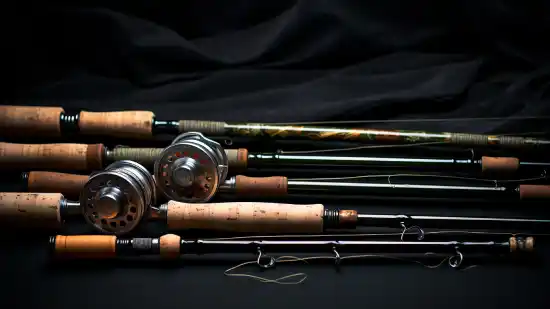
Many fly anglers, like yourself, often find themselves fond of 6-weight (6 wt) fly rods for a variety of reasons. Here are some reasons why many anglers prefer 6 wt fly rods over 5 wt rods:
1. Specialized Fly Lines
To fully utilize the advantages of a 6 wt fly rod, you’ll find a wide selection of specialized fly lines catered towards targeting specific fish species or fishing conditions. These specialized lines are designed to enhance your fishing experience and provide optimal performance.
Here are four key types of specialized fly lines available for your 6 wt rod:
- Redfish Line: This line features a taper specifically designed for casting large flies and handling windy conditions, making it ideal for targeting redfish in coastal waters.
- Bonefish Line: With a long, delicate taper, this line allows for precise presentations and delicate presentations needed when pursuing spooky bonefish on shallow flats.
- Bass Line: Designed with a shorter and more aggressive front taper, this line allows for accurate casting and effortless turnover of large, bulky flies, perfect for enticing bass in freshwater environments.
- Saltwater Line: This line is built to withstand harsh saltwater conditions, with a heavier weight-forward design that aids in casting larger flies and dealing with strong winds encountered while fishing in the salt.
These specialized fly lines ensure that your 6 wt rod is optimized for specific fishing situations, giving you the versatility and control needed to target different fish species and adapt to various fishing conditions.
2. Casting Capabilities
With a 6 wt rod, you’ll quickly notice its impressive casting capabilities, allowing you to deliver your flies with accuracy and precision effortlessly.
The unique combination of attributes in a 6 wt rod provides you with the perfect balance of delicacy and strength.
Despite the rod’s stronger backbone, the sensitive tip section allows you to present flies that are softer and more wind-resistant. This is especially important when precision and authority in casting are paramount.
The 6 wt rod paired with a correctly balanced fly line provides a level of control and finesse that a medium-fast rod like a 7 wt simply can’t match.
Whether you need to cast into a stiff breeze or delicately present a dry fly, the 6 wt rod’s casting capabilities will exceed your expectations.
3. Fighting Butt or Grip Option
The fighting butt is a valuable feature that provides comfort and control during intense battles with fish. When you’re in the midst of a long and arduous fight, the fighting butt ensures a secure grip, reducing the chances of losing your catch.
Here are some key benefits of having a fighting butt on your 6 wt fly rod:
- Increased leverage: The extended length of the fighting butt allows you to apply more force when fighting against larger species like bass in the sea.
- Better weight distribution: By shifting some of the weight towards the rear of the rod, the fighting butt helps to balance the rod and reduce fatigue during extended fights.
- Improved stability: Whether you’re bracing the rod against your body or arm, the fighting butt provides a stable contact point, allowing for better control over the fish’s movements.
- Enhanced comfort: The padding on the fighting butt provides a cushioned grip, minimizing discomfort and strain on your hands during prolonged battles.
4. Fish Species Versatility
The 6 wt fly rod’s versatility extends to its ability to handle many fish species. This is due to its optimal balance between power and finesse. Whether you are targeting bass, trout, smaller steelhead, or even salmon, the 6 wt will provide you with the necessary strength to handle these fish effectively.
The rod’s medium-fast action allows for precise casting and accurate presentation, ensuring that you can effectively mimic the natural movements of various prey species. The 6 wt’s backbone also provides the lifting power to fight larger fish and navigate challenging fishing conditions.
Its versatility also extends to different fishing environments, whether you’re fishing in freshwater rivers, lakes, or even saltwater flats. Overall, the 6 wt fly rod’s adaptability makes it an excellent choice for anglers seeking to target a wide array of fish species.
5. Versatility for Different Fly Sizes
When casting larger dry flies, a 6 wt rod offers the extra power needed for effortless casting. With a 6 wt rod in hand, you can confidently tackle the challenge of casting size 6 grasshopper flies or even size 4 dry flies. This added power allows you to punch through the wind and deliver your fly accurately to the target.
The versatility of a 6 wt rod becomes evident as you adapt to different conditions and fly sizes throughout the day. Here’s how a 6 wt rod enhances your fly fishing experience:
- Increased line control and accuracy for casting larger flies
- Improved ability to cast in windy conditions
- Enhanced distance casting capabilities
- Better control and management of heavy fly lines
With a 6 wt rod, you’ll have the necessary power and control to handle a variety of fly sizes, ensuring a successful day on the water.
Can a 6-weight fly rod be used for both freshwater and saltwater fly fishing?
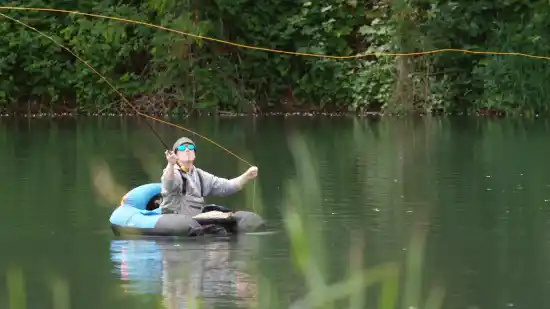
A 6-weight fly rod can be used both for freshwater and saltwater fly fishing. Its versatility allows you to pursue a wide range of fish species in different environments without the need for multiple rods.
In freshwater, the 6-weight rod is perfect for trout, bass, and smaller steelhead fishing. Its medium action allows for delicate presentations while still providing enough power to handle larger fish.
When fishing into saltwater, the 6-weight rod is well-suited for species like redfish and bonefish. Its sturdy construction and ability to cast larger flies make it an excellent choice for anglers looking to explore saltwater fly fishing.
What kind of fly lines are suitable for a 5-weight fly rod?
For a 5-weight (5WT) fly rod, a floating Weight Forward (WF5) fly line is typically the most suitable choice for a wide range of fishing scenarios. This versatile line can handle various fly sizes and is particularly well-suited for trout fishing in freshwater settings, where delicate presentations are often necessary.
Its design allows for easy casting and control of the line, making it an excellent all-purpose option for 5WT fly rods.
However, for specific fishing conditions or when targeting different species, anglers may opt for specialized lines, such as sink-tip lines or nymphing lines, to tailor their setups accordingly.
What is the ideal length for a 5wt fly rod?
To achieve the best balance between casting accuracy and line control, you should consider a 9-foot length for your 5wt fly rod.
A 9-foot rod provides the ideal length for most trout fishing scenarios, offering versatility and precision in your presentations.
With this length, you’ll have the necessary reach for various casting techniques, allowing you to target trout in small to medium-sized rivers and streams effectively.
The 9-foot 5wt rod has become the go-to choice for many trout anglers due to its widespread recommendation and availability. Its effectiveness is undeniable, making it a reliable option for those who may be unsure about selecting a rod length.
Embrace Your Fishing Adventure with the Perfect Fly Rod
You now have a comprehensive understanding of the main differences between 5 wt and 6 wt fly rods, each tailored to specific angling needs.
Your choice between these two rods hinges on factors like target species, fishing conditions, and the versatility you require. The 5 wt rod shines in delicate presentations for smaller trout, while the 6 wt excels in handling larger fish, current windy conditions, and diverse warm-water species.
Ultimately, your decision should align with your angling aspirations. Whether you’re chasing mountain trout, the right fly rod can make all the difference in your fly fishing adventures.

